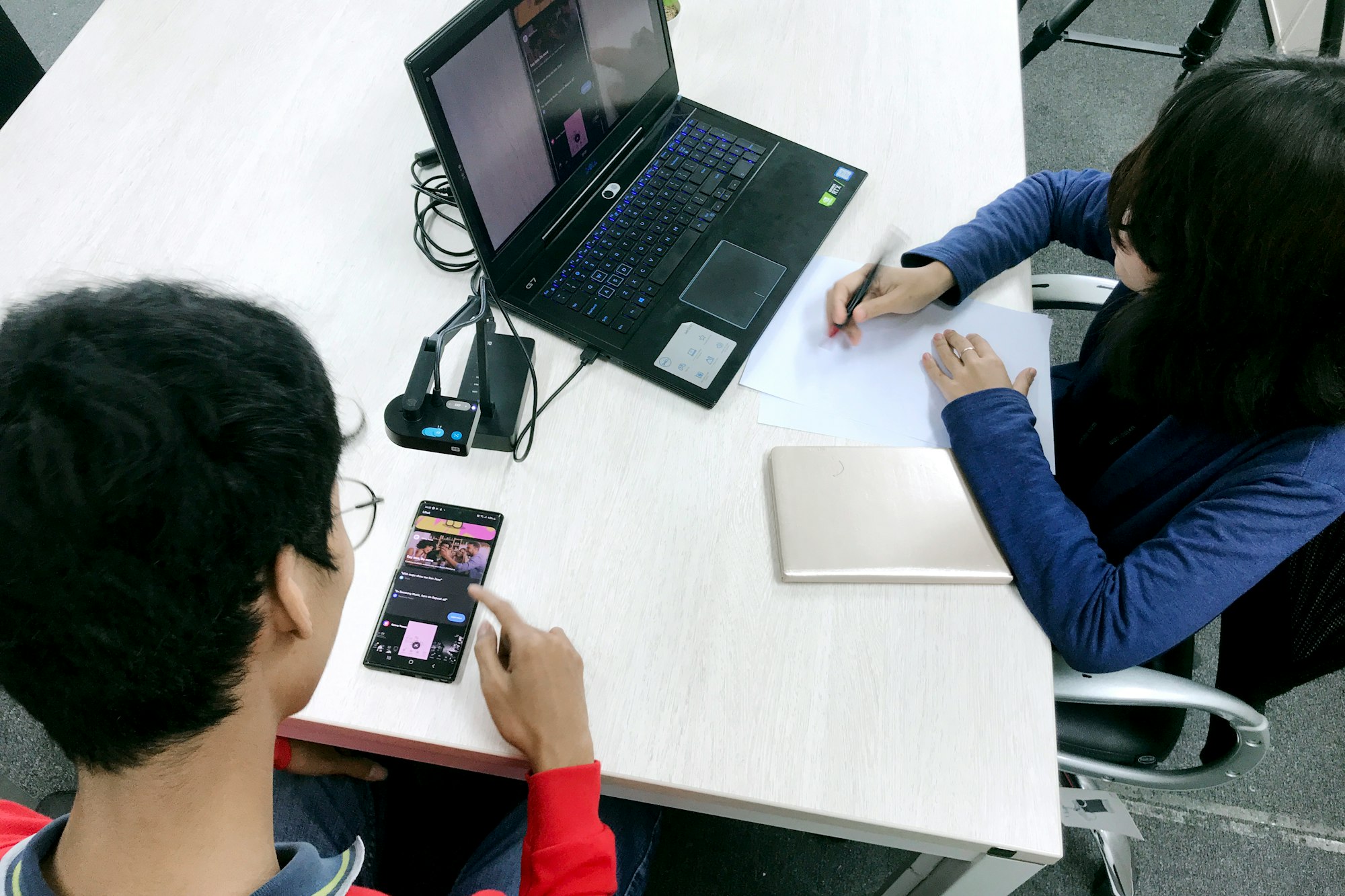Improve your product with user testing

Designing a prototype is hard, but since you cannot get a feel for a product without building it - we often make many assumptions. The only way to really learn what your users want, however, is by getting their opinion through user testing. User testing helps you create better products faster by validating your assumptions throughout the design process and gaining valuable feedback from testers before you waste time building something no one wants.
What is user testing anyway?
User testing is a form of usability testing that allows you to test your prototype on "real" people. It's a process of user feedback for your website, mobile app, or prototype. User testing is more than just viewing a website or mobile app -- it's about seeing how your visitors respond to your design. User testing allows you to validate key decisions throughout your design process. This value comes from observing how people interact with your product, rather than asking them how they would use it. User testing also gives you an opportunity to show users the intended design and get feedback on your product before you start coding.
User testing is a relatively inexpensive way for you to get more information on how your target audience interacts with a specific aspect of your design. By getting real participants who have never seen the design or interacted with its components before, you can learn how to better address your users’ needs.
Most people don’t know that user testing is their secret power 🤫
The goal of a user test is to learn how a real person will use a product. For example, a company may be designing a new website for its customers. By testing the website with real people, they can learn how easily people can find information on the new website, or they can learn how easy it is for people to make purchases.

It can be done in many ways: through surveys, observation, interviews, and tests. The goal of such activities is to get actionable insights that can be used to improve the product or to help verify if ideas are viable or not.
But most importantly it will allow you to:
- See if your users understand your product.
- Identify and fix bugs faster
- Crafting beautiful designs
- Giving your product team valuable insight into user behavior.
- Test the usability & the whole user experience
- Discover alternative solutions that you & your team didn’t think about
- Discover where your user pain points are
- Developing smarter UI and UX in general.
Should you invest in user research?

Every product is made of different factors. Without the experience factor, the product would not be very good. The experience factor can make or break a business or product! Experience is what makes you want to use something over and over again, remember about it, refer it to friends, etc. That is why it is vital that 10% of every budget should be designated for UX design within your product teams!
Product design is an ever-changing field. Recently, product designers have seen a shift in their work from designing products to creating user experiences. Your product will not be successful without the support of your customers, but in order for them to fall in love with what you do, it needs to represent the right type of experience for them. Starting with good research allows you to set out with a clear understanding of who your target audience is before creating the best possible user experience.
When it comes to creating a high-quality product that people can use without much trouble, it’s necessary to know your audience well. As you know by now, one of the biggest enemies of usability are pitfalls. Potholes are subtle mistakes or poor design decisions that create issues for customers and make your apps seem sloppy.
Here are 3 ways to invest in UX design & can elevate your product:
- Test many customer personas
- Develop more effective products by eliminating the guesswork
- Prioritize tasks quickly and deliver the best version of your product
Should I always offer incentives?
When you're in the early stages of designing something, it's best to use incentives in order to get people to follow through with helping you out. Usually, when they receive vouchers or a free product, they respond better under pressure when there are deadlines involved. I would recommend using this method when paying users cash prizes/vouchers sums ranging somewhere between $50 - $100 for each test participant.
How does a user testing process work?
User testing is a process that can be used to get feedback from customers, users, and end-users on a product, service, or feature. It is a method used in UX and UI design and consulting. User testing can be performed at any point in the design cycle and is designed to give the designer and team insight into how users interact with a product. The process of conducting a user testing session is relatively simple.
How do you choose the right usability test type?
There are so many options for creating your product! From surveys and focus groups to A/B testing and beta testing, there's no shortage of ways you can go about doing user-centered design. The questions you should be asking yourself at this point are
1. "When do I need these results?"
2. "What kinds of information am I hoping to gather by talking to my users?"
You'll want to prioritize the five techniques if the answer is
1) right away and
2) quantitative information like demographic data.
On the other hand, if you're looking for qualitative feedback from your users (e.g., their thought process during a certain action), then survey ratings or reactions during a usability test would probably be your best bet.
Draft the Test Plan:
It can be broken down into multiple steps:
- Create a feature or a product.
- Choose a testing method.
- Find users to complete the test. (ask your existing customers or find it in different social media industry-related groups
- Define the process: how you'll be testing users.
- Define the test duration.
- Analyze results.
Before launching into the user testing process, there are a few pre-testing tasks you have to do first in order to be prepared. These include but are not limited to deciding on a test topic, scope, and purpose, choosing the stakeholders who will interact with users for this test, deciding what methods of interaction will be used in this area - whether whiteboard sketching or something else.
When selecting a customer to test your product with, it is important to take into consideration the fact whether or not the identified user's goals, values, and constraints line up with how your product might potentially help them.
It’s useful and beneficial to understand why people behave the way they do. Acting as a user and thinking like them is a critical step in understanding how they feel about your product. But to get a harsh truth of your product, it is vital that you test it with real people who also belong to the target audience; there’s no better way of understanding what different types of people really feel about your product than by getting them involved.
Here are 4 user testing tips you should pay attention to:
- Define the area of focus
- Talk to your users
- Record sessions for analyzing
- Set priorities
What are the different types of user testing?
Questionnaires aren't just something psychologists use to get information out of you about your parents. 😅
They're also great at asking for feedback about what's working and what's not in an app or website design. And it gets better - these super simple tools are very fast, affordable, and provide precise results in no time at all. Now you could move straight to user testing if it seems like you've got the right idea down, but I'd try a questionnaire first because they give you a sense of if people respond to certain design elements well by letting you know which things they click on without having to videotape a whole lot of stuff or make a whole lot of notes. This leads me to my next point…

Video testing
It allows you to watch a recorded video of one or more people as they use the system your app/tool.
There are two ways to go about conducting video tests:
- You can let your users record their own videos with the software of their choice
- or you can set up recording equipment and let them go through different tasks in a video call with reports after each task is complete.
Recording software allows them more freedom because it will give them time to think about what they want to say but it may be harder for you to know if there is something working properly if there are no screen recordings showing the user's computer screen during errors.
If you opt for setting up recording equipment, make sure that your subjects are aware of how much time is left in the session so they don't feel rushed, and ask that they speak clearly into the microphone so that everything is clear during playback.
Card sorting
Conducting a card sort is a great way to get feedback from your participants about what they think of their experience using the product. It’s usually interesting and fun and can generate great ideas and opinions on how to improve and better your product. Conducting these tests will give you an idea of where the most impact can be made in improving your app and where you should go next in case certain features need work.
A/B testing
While testing a single user can certainly provide a few good insights about how a particular product works, but what if you have a number of different users who collectively take the place of a wider target audience? In this case, you might think about using split testing as an additional method to measure potential effectiveness.
Split-testing is a friendly way to compare different testing options for your website. For example, two versions of your homepage will be shown to two groups of people randomly without any overlap between them. You can then determine which version is most effective by measuring the effects of one version over another.
Interviewing
If you're conducting an interview, it's helpful to know what type of message you're intending to convey by providing examples with which your potential interviewees can relate. Once the messaging is clear, then it's important to listen! Don't try to interject or interrupt your subject with questions; simply let them speak until they've finished. Then, ask probing questions designed to elicit more detailed answers (i.e., "Tell me more about that…" or "How did that make you feel"?). When an idea isn't getting across, go back and rephrase it using different words.
Analyze and learn from your users

When it comes to usability testing, there are many tools available to test your products, but likely one of the most under-rated options is good old-fashioned conversation.
At the end of a usability test, you'll want to share your findings with the rest of your team.
It's important to create a report to share with your team so they can understand the issues and how to fix them. A well-made report will include many specific pieces of information such as what users said they liked and didn't like about specific different parts of your site or app or what your overall impressions were. Furthermore, you want to share other findings like problems they found and features that work well or not so well.
This step is really important as it will determine the future of the product by prioritizing and planning future design interactions to improve user experience.
“The design is not just what it looks like and feels like. The design is how it works” - Steve Jobs
Reduce your product failures
Conducting user tests can be fruitful, especially if you are attempting to build a product. It helps you know what the users find relevant for your application, but also it helps you understand how well they are able to navigate through your app. This is important for creative projects because it allows you to make sure that the flow makes sense for your end-users.
In the end, it is always good to make a prototype as you can only get a feel for a product without building it. However, without testing your assumptions along the way, you can never be sure that you are building the right thing. You can build your prototype using one of your favourite design tool such as Adobe XD, or Figma and create your first version of your website with Yotako.
Let us know on our social media what you think of this article and if it was helpful.

